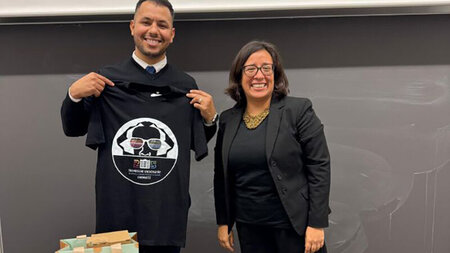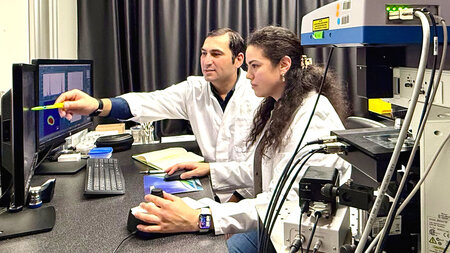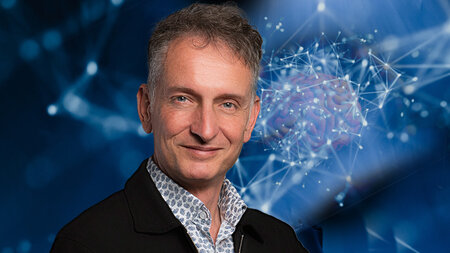Research profile
Modelling of electronic and optical properties of new semiconductor materials
For the development of new semiconductor materials and devices a simulation of the optical properties is useful in many ways: For the estimation of the (scientific and economic) potential of a material, for the optimization of the structural parameters, for the detection of loss processes etc. Basic requirement of such simulations is a parameter-free theory, which is not dependant on parameters and thus constant experimental input. Therefore, only numerically very complex and elaborate methods are applicable, e.g. many-particle theories or multi scale simulations. Parameters of semi empiric methods can therefore be extracted from ab initio calculations of microscopis systems to perform macroscopic simulations.
Monte Carlo simulations are often used to look at the movement of individual charge carriers through a material to determine significant quantities such as charge carrier mobility or conductivity. The charge carriers can then pass from one molecule to a neighbouring one (hopping). Through these repeated random movements, the desired quantities can be estimated. For the correctness of the results, however, the knowledge of the probabilities for such a transition as well as the dependence of these probabilities on displacements or tilts of the molecules is of fundamental importance.
Currently, we model and determine these hopping rates using Marcus transfer theory as well as by treating the electronic structure of the molecules based on density-functional-based tight binding (DFTB), implemented in the software package dftb+. The aim is to calculate a distribution of these transition probabilities for different molecules or combinations of molecules depending on their relative geometric orientations.
Cooperations:
Florian Günther (Universidade de São Paulo, Instituto de Física de São Carlos, Brazil)
Theses:
R. Silligmann: Bestimmung von intermolekularen Übergangsraten in Abhängigkeit der geometrischen Freiheitsgrade mittels first principles Methoden, Masterarbeit
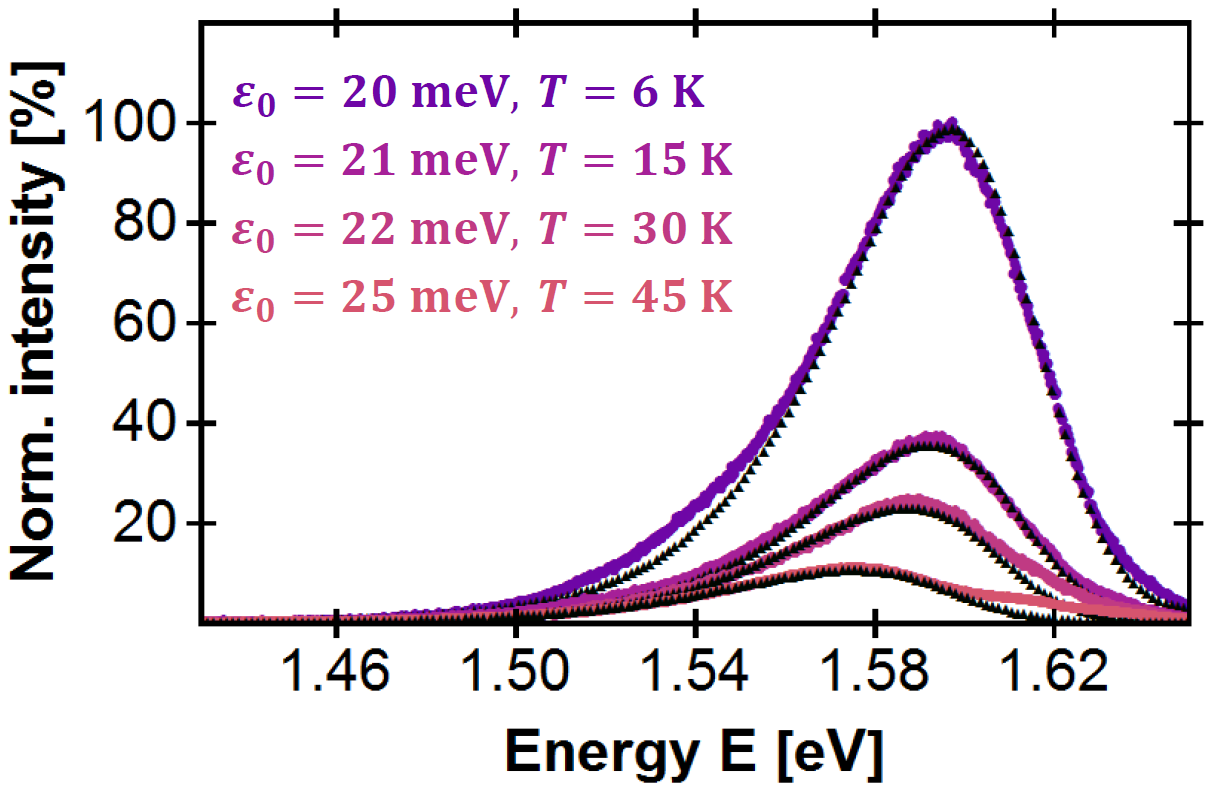 Photoluminescence spectrum of MoS2
Photoluminescence spectrum of MoS2
Monte Carlo simulations can be used to look at the movements of individual charge carriers and excitons through a material. Based on material parameters, it is possible to simulate macroscopically large systems and carry out extensive parameter studies. The charge carriers and excitons can thereby pass from one molecule to a neighbouring one (hopping). Through these repeated, random movements, desired quantities such as charge carrier mobility and conductivity can be determined.
We are currently investigating the photoluminescence of low-dimensional disordered materials, which are used for solar cells, for example. For this purpose, we perform kinetic Monte Carlo simulations for exciton hopping with periodic boundary conditions, explicitly including exciton-exciton interactions and approximating them by attractive dipole-dipole interactions in the limit of large distances.
Theses:
M. Schwuchow: Hopping von Ladungsträgern in niedrig-dimensionalen Halbleitern mit Unordnung: Simulation von Photolumineszenz unter Berücksichtigung von Coulomb-Wechselwirkung, Masterarbeit
Publications:
C. Wagner et al.: Kinetic Monte-Carlo Simulation of Exciton Hopping: Urbach Tails in Gas-Molecule Decorated MoSe2, Phys. Status Solidi B, Vol. 258, 11, 2100186 (2021)
M. Schwuchow et al.: Mirror particle effects in kinetic Monte Carlosimulations including Coulomb interaction withperiodic boundaries, International Conference on Numerical Simulation of Optoelectronic Devices (NUSOD), (2021)
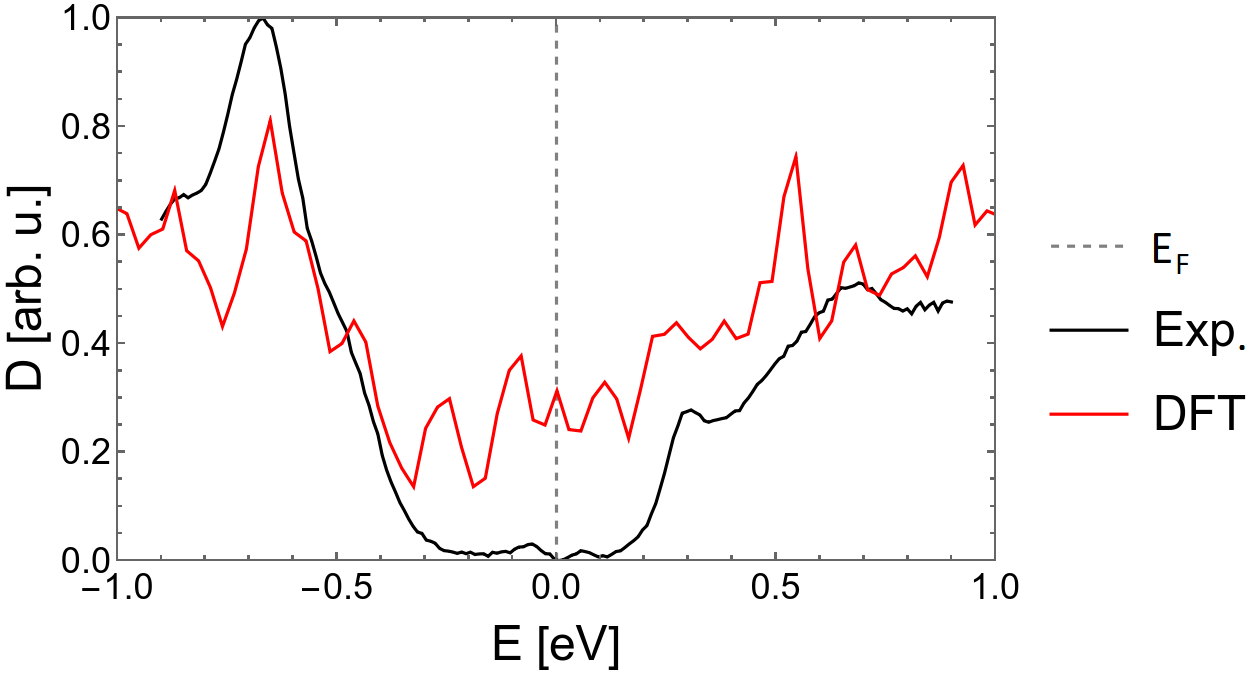 Density of states of 4 layers of Bismuth on graphene, comparison of theory vs. experiment
Density of states of 4 layers of Bismuth on graphene, comparison of theory vs. experiment
Bismuth shows a variety of interesting properties, both as a bulk material and as a thin film. E.g. bismuth is a topological insulator, shows strong spin-orbit effects, has a semi-metal-semiconductor transition with respect to film thickness and thin layers show quantum well states similar to those of the harmonic oscillator.
The current goal is the comparison of experiment and theory of thin bismuth (110) layers on graphene to gain insights into the structure and electronic properties. With the help of density functional theory calculations for bismuth (110) multilayers on graphene, the structural and electronic properties are investigated. Especially the crystal structure and the density of states in dependence of the number of layers is of interest. Comparisons can then be made with scanning tunnelling microscopy measurements.
Cooperations:
Christoph Tegenkamp, Chitran Ghosal (TU Chemnitz)
Uwe Gerstmann (Universität Paderborn)
Publications:
F. Teichert et al.: Do equidistant energy levels necessitate a harmonic potential?, Optical and Quantum Electronics 53, 403 (2021)
Laser dynamics and non-equilibrium effects
Lasers are becoming more important within many areas of the everyday life, e.g. telecommunications and the medicine. Theoretically they are however often described with very simple models, which presuppose an equilibrium distribution of the charge carriers in the semiconductor laser, for example due to the high density and fast scattering. This approximation is particularly doubtful for lasers with very high output, however is mostly usually used for numerical reasons. A modeling of the full dynamics of the charge carriers requires a high computational effort, is however quite possible on modern computer systems and shows interesting effects, such as a possible optimization of laser systems in terms of performance or speed by variation of the shape of the stimulating pulse.
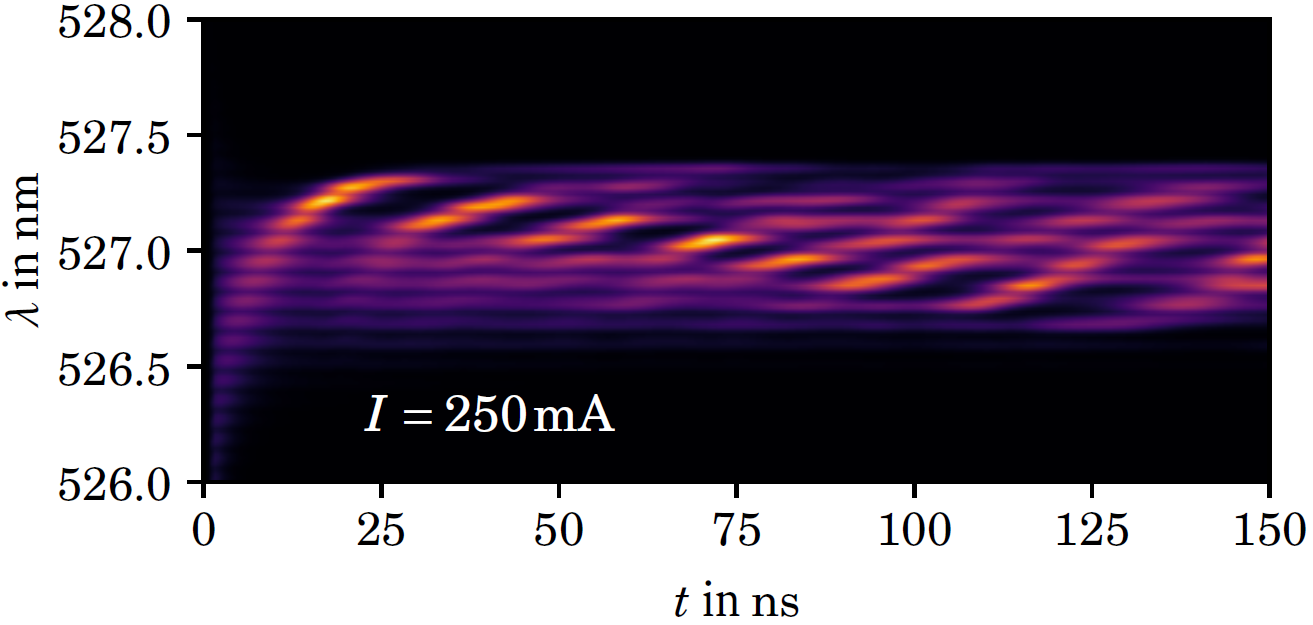 Mode dynamics of a lase diod showing the mode rolling effect
Mode dynamics of a lase diod showing the mode rolling effect
Simple models for simulating laser dynamics are often based on rate equations. However, these are often insufficient to describe various effects that occur in reality and are caused by many-body effects. For a more detailed and exact description, microscopic many-particle theories must therefore be used, such as the semiconductor Bloch equations with included Coulomb and electron-phonon scattering.
We are currently simulating (Al,In)GaN-based edge-emitter laser diodes. These show longitudinal mode competition phenomena, which are responsible for the mode hopping effect, i.e. the modes are switched on and off, resulting in mode rolling from high to low frequencies. This effect is caused by oscillations of the charge carrier density, which leads to an asymmetric coupling between neighbouring modes.
Cooperations:
Ulrich T. Schwarz (TU Chemnitz)
Theses:
E. Kuhn: Simulation der Modendynamik von Fabry-Pérot-Laserdioden unter Berücksichtigung mikroskopischer Effekte, Dissertation
Publications:
E. Kuhn et al.: Modeling mode competition in laser diodes, Optical and Quantum Electronics 51, 206 (2019)
E. Kuhn et al.: Mode rolling effects in nitride laser diodes, Engineering Research Express 2, 035036 (2020)
Phoxonic (photonic and phononic) crystals
Phoxonic crystals are metamaterials with periodically varying material properties. Analogous to crystal lattices from solid-state physics, the phenomenon of allowed and forbidden energy ranges occurs – only not for electrons, but for phonons or photons.
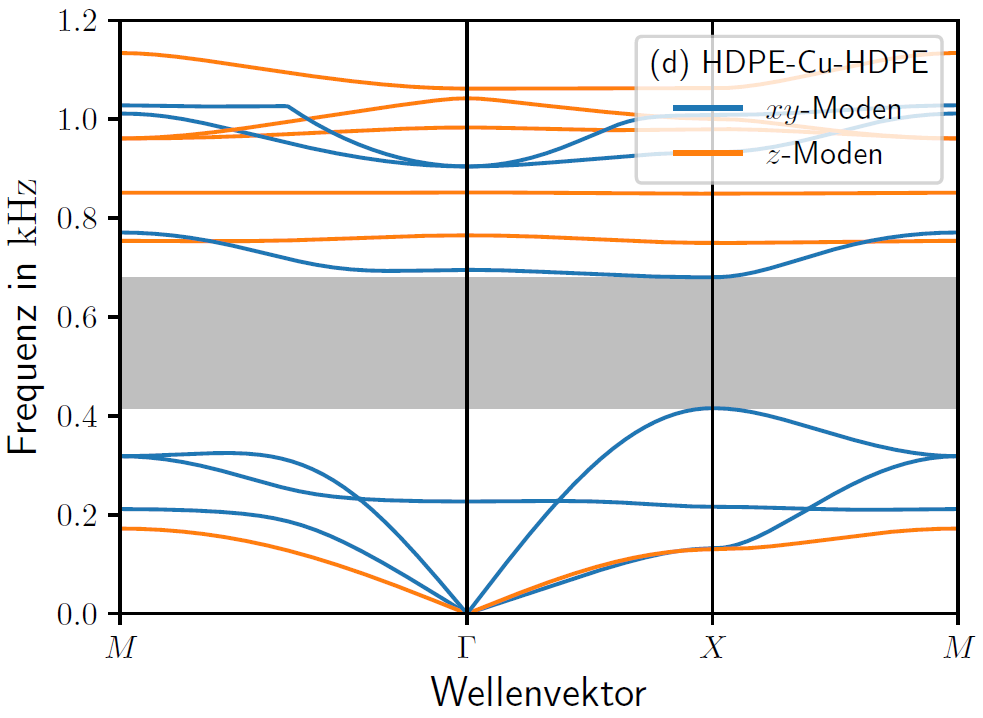 Bandstructure of a phononic crystal
Bandstructure of a phononic crystal
In phononic crystals, among other things, the density varies periodically in space, which means that the propagation of mechanical (e.g. acoustic) waves can be manipulated in various ways. Due to their special properties, phononic crystals promise numerous applications such as acoustic mirrors, noise and vibration isolation, reduction of the group velocity of sound waves, and even influencing thermal properties on the nanometre scale by manipulating lattice vibrations.
We model the sculpture "Thinking and Perception Model on the Phenomenon of Colour" on the campus of the TU Chemnitz. This work of art fulfils the requirements of a phononic crystal through the periodic variation in the form of regularly arranged metal rods surrounded by air. We calculate band structures for different material combinations based on the dimensions of the artwork.
Theses:
D. Röhlig: Modellierung zweidimensionaler phononischer Kristalle, Bachelorarbeit
Photonic crystals have a refractive index that varies periodically over time. These are able to significantly influence the propagation of electromagnetic waves. The fact that amorphous photonic crystals are less angle-dependent in their reflection properties than ordered structures makes them particularly interesting for the production of structural colours. As anti-reflective coatings, they also enable the efficiency of solar cells to be increased.
We are currently investigating the influence of disorder in two-dimensional photonic systems. By means of arrangements of dielectric cylinders in the square lattice, it is tested to what extent disorder with respect to the regular lattice positions, the radii, the dielectric constants or imperfections affects the transmission spectra and which mechanisms determine possible changes. Of particular interest is the transition between ordered and amorphous photonic crystals.
 High transmission electromagnetic wave in a photonic crystal
High transmission electromagnetic wave in a photonic crystal
Cooperations:
Thomas Blaudeck (TU Chemnitz, Center for Materials, Architectures and Integration of Nanomembranes (MAIN))
Theses:
D. Röhlig: Unordnung in photonischen Strukturen – Theorie und Anwendungen, Masterarbeit
Publications:
E. Kuhn et al.: Disorder explains dual-band reflection spectrum inspherical colloidal photonic supraparticle assemblies, Nano Select 2, 12, 2461 (2021)
D. Röhlig et al.: The Role of Disorder in Elementary Photonic Components, IEEE Proceedings, Smart Systems Integration (SSI) 2022, 9901424 (2022)
D. Röhlig et al.: Simultaneous occurrence and compensating effects of multi-type disorder in two-dimensional photonic structures, Nano Select 4, 6, 368 (2023)
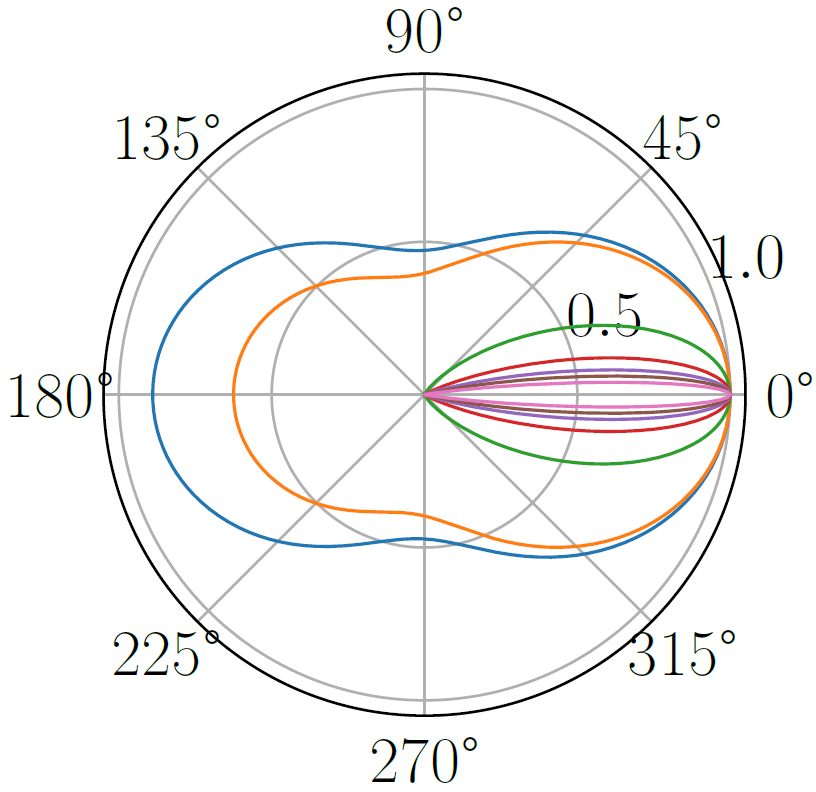 Intensity distribution after scattering of an electromagnetic wave by a polymer sphere of different diameter
Intensity distribution after scattering of an electromagnetic wave by a polymer sphere of different diameter
Currently, more than 5 percent of the world's population suffers from hearing loss. The most common cause of impairment of this sensory function is a malfunction in the cochlea. This is also referred to as sensorineural hearing loss. One approach to solving this problem is optical cochlear implants. Here, the electrodes are replaced by light emitters.
We are currently investigating how the interaction of monochromatic light and tissue behaves and to what extent this relationship can also be simulated with tissue phantoms. Different approaches of ray and wave optics are used for simulation and are compared.
Cooperations:
Ulrich T. Schwarz, Lea Schott (TU Chemnitz)
Theses:
T. Witke: Simulation winkelabhängiger Lichtstreuung in Gewebephantomen für die Anwendung von optischen Cochlea-Implantaten, Masterarbeit
Renewable energies and species protection
Against the background of global crises and the finite nature of fossil fuels, renewable energies are becoming increasingly important. One of the now most established ways to develop them is through the expansion of wind farms. In order to prevent the so-called "greening" of rural regions, the shallow marine space around the coastal regions in the North and Baltic Seas is increasingly being used for the construction of offshore wind farms. According to the Ministry of Energy and Climate Protection, the installed capacity of offshore wind energy in Germany is to increase to at least 30GW by 2030 and to 70GW average capacity by 2045.
The construction of large wind farms poses major challenges for both companies and the public sector in terms of the protection and conservation of marine habitats. Native fauna in particular is exposed to great sound pollution. To anchor the foundations of the wind turbine shafts in the seabed, metal pillars are driven into them with hydraulic hammers. Peak sound levels of up to 200 dB are achieved. Since 2013, the noise protection concept for offshore expansion in the North Sea has been in force, which states that the peak sound pressure level of 190 dB must not be exceeded. One approach to reducing the noise generated during continuous operation is being developed in the form of a "bubble curtain". Here, a tube with an inner diameter of 100 cm is placed around the shaft of the wind turbine on the seabed. This emits a constant stream of bubbles with a varying diameter of 1-3 cm. The aim of our investigations is to describe the emitted sound of the wind turbine shafts as well as the influence of the interference by means of computer simulations and to discuss their impact on the fauna of the North Sea using harbour porpoises as an example.
Kooperationen:
Joseph Schnitzler (Tierärztliche Hochschule Hannover)


